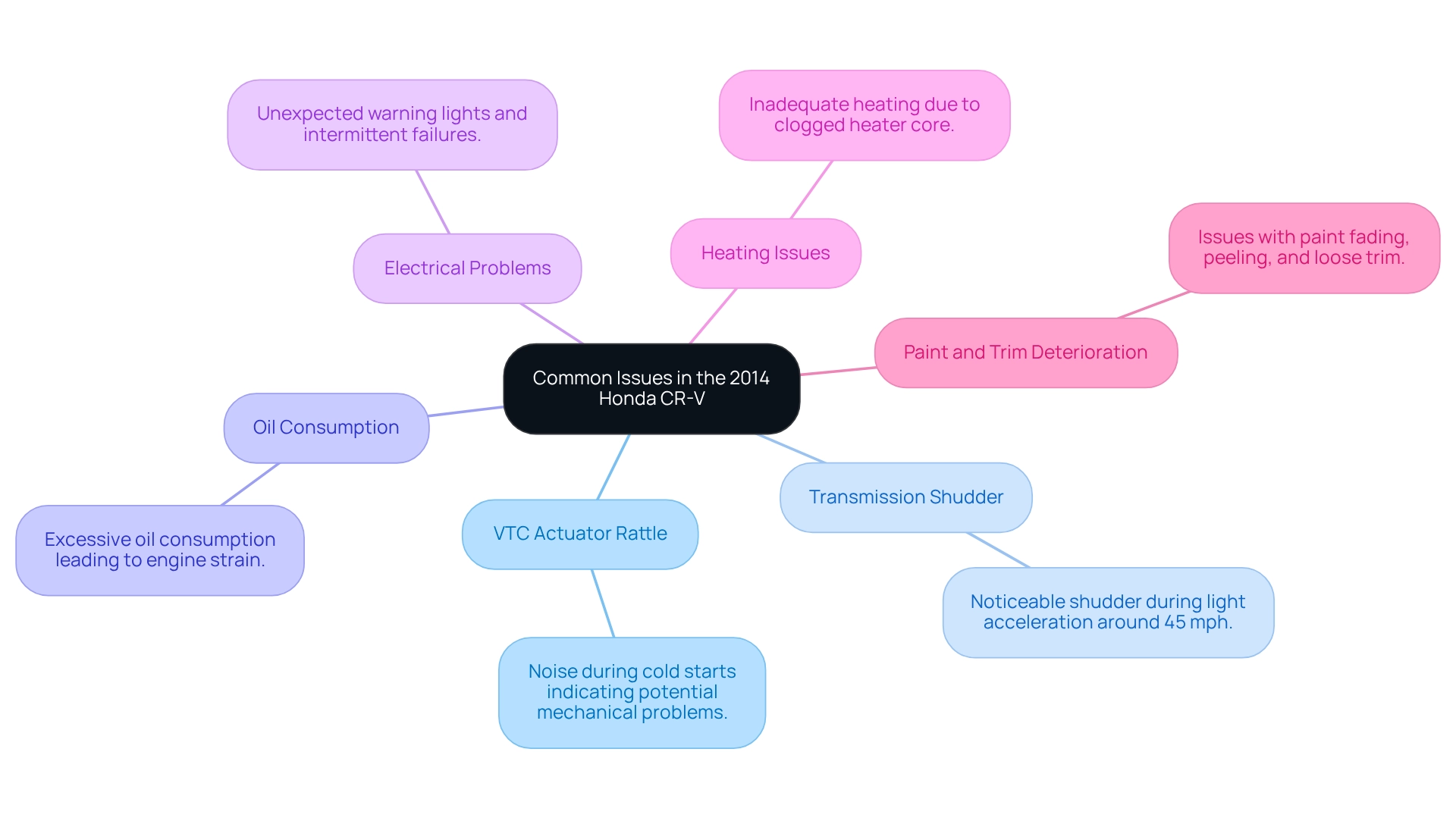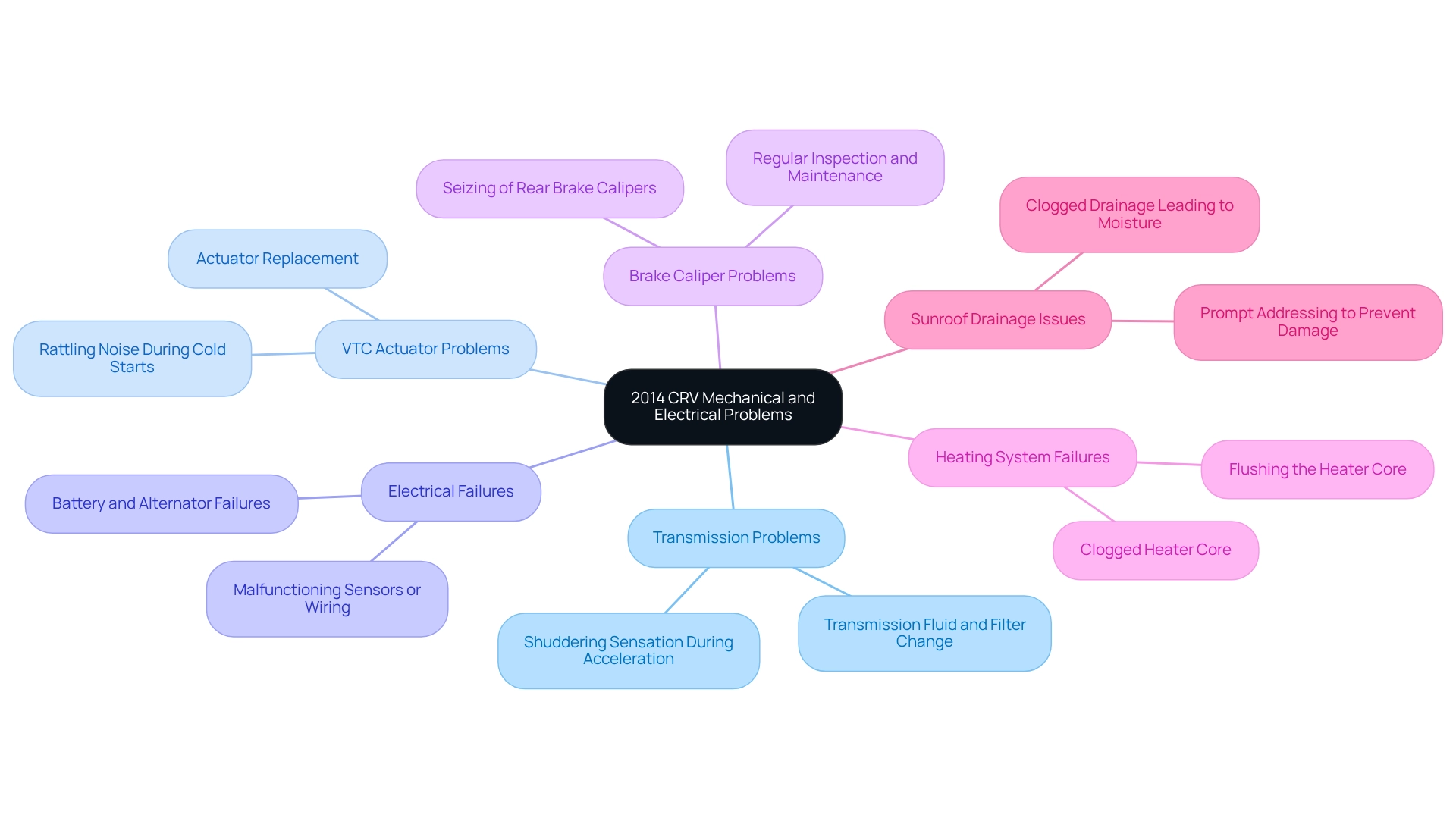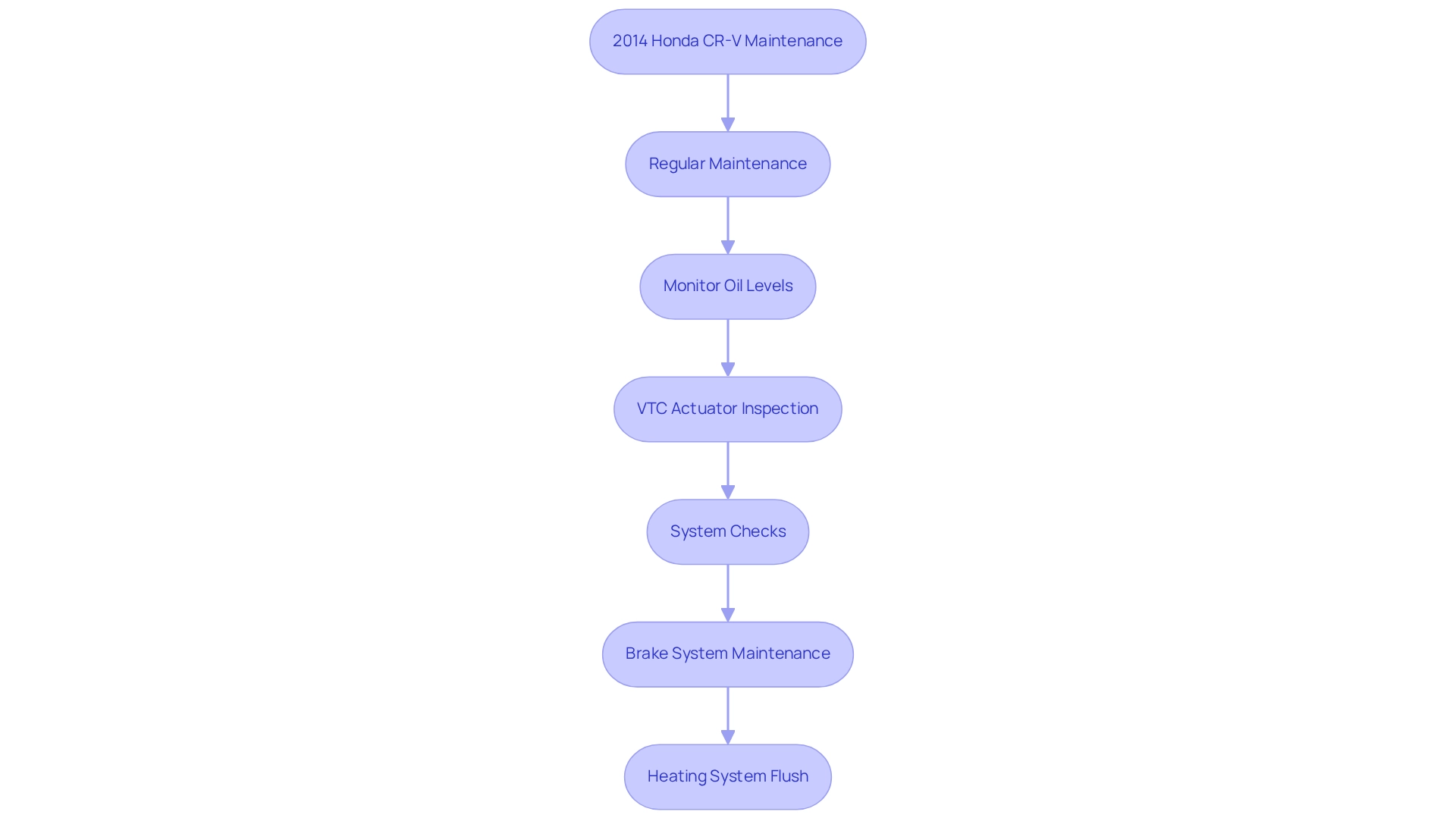Addressing 2014 CRV Issues: Solutions for Common Problems

Overview
The article addresses common issues faced by the 2014 Honda CR-V, such as:
- VTC actuator rattle
- Transmission shudder
- Excessive oil consumption
- Electrical problems
- Heating issues
It offers practical solutions for these concerns, emphasizing the importance of regular maintenance and proactive measures. By conducting timely inspections and repairs, owners can enhance the vehicle’s reliability and extend its lifespan. This approach supports owners in mitigating these reported problems effectively.
Introduction
The 2014 Honda CR-V is well-regarded for its reliability. However, like any vehicle, it is not without common issues that can affect performance and owner satisfaction. These concerns can manifest as unsettling mechanical noises or frustrating electrical failures, ranging from minor annoyances to significant safety risks.
This article explores the most frequently reported problems by CR-V owners, including:
- Transmission shudders
- Oil consumption
- Heating system failures
Additionally, it provides practical solutions and preventive measures to help maintain the vehicle’s integrity and enhance the driving experience. By understanding these challenges and how to address them, Honda CR-V owners can ensure their vehicles remain dependable companions on the road.
Overview of Common Issues in the 2014 Honda CR-V
The 2014 Honda CR-V is widely recognized for its dependability, yet users have reported several 2014 CRV issues that warrant attention. Key concerns include:
-
VTC Actuator Rattle: This noise, often heard during cold starts, may indicate underlying mechanical problems. Reports suggest that this issue has recurred for some individuals, highlighting the need for thorough inspection. One owner remarked, “Rattle during cold starts… happened years ago and dealer fixed. Now, the same thing is happening again. I think it’s a regulator or something.”
-
Transmission Shudder: A noticeable shudder during light acceleration, particularly around 45 mph, has been frequently mentioned. This can detract from the driving experience and may necessitate diagnostic evaluation.
-
Oil Consumption: Some drivers have reported excessive oil consumption, which, if left unchecked, can lead to significant engine strain and potential long-term damage.
-
Electrical Problems: Unexpected warning lights and intermittent electrical failures have been observed, raising concerns about the vehicle’s electrical system reliability.
-
Heating Issues: A clogged heater core can result in inadequate heating, particularly problematic in colder climates, affecting passenger comfort.
-
Paint and Trim Deterioration: Owners have noted issues with paint fading, peeling, and loose trim, including paint coming off the hood and degradation of rubber strips. These aesthetic concerns can potentially decrease resale value.
Additionally, the 2014 CRV issues include one recall identified, although recalls may not affect every vehicle of the same year, make, and model. Awareness and proactive maintenance can help mitigate these concerns, ensuring a more dependable driving experience.

Mechanical and Electrical Problems Reported by Owners
Owners have reported several mechanical and power-related problems, known as 2014 CRV issues, that can affect performance and safety. Understanding the 2014 CRV issues is crucial for maintaining the vehicle’s reliability and ensuring a safe driving experience, especially concerning transmission problems like a shuddering sensation during acceleration, particularly noticeable when shifting from second to third gear. This issue can often be mitigated by changing the transmission fluid and filter, which helps maintain optimal performance and prolong the life of the transmission.
VTC Actuator Problems: The Variable Timing Control (VTC) actuator may produce a rattling noise, especially during cold starts. Replacing the actuator is typically necessary to eliminate this noise and ensure smooth engine operation, enhancing overall driving comfort.
Electrical Failures: Many users have experienced electrical problems, including battery and alternator failures, as well as warning lights activating without apparent cause. These issues are frequently associated with malfunctioning sensors or wiring, which can be identified and fixed by a skilled technician, thus restoring the vehicle’s functionality.
Brake Caliper Problems: Some individuals have reported that the rear brake calipers can seize, causing early wear on brake pads. Regular inspection and maintenance can help prevent this issue, ensuring safe braking performance and reducing long-term repair costs.
Heating System Failures: A clogged heater core can result in inadequate heating, particularly problematic during winter months. Flushing the heater core can restore proper function and comfort, making winter driving more pleasant.
Sunroof Drainage Issues: Furthermore, individuals have reported that drainage from the sunroof can become clogged, resulting in moisture inside the cabin during rain. Addressing this issue promptly can prevent further complications, such as mold growth and interior damage.
These insights reflect the complexities of vehicle ownership and underscore the importance of proactive maintenance. For instance, some individuals have taken to actively monitoring their oil levels and conducting analyses to assess fuel dilution, demonstrating a growing awareness of the significance of regular vehicle maintenance. As one owner, ‘smitcat,’ aptly put it, ‘Life is too short to worry about things such as this,’ highlighting the need for effective solutions to these common problems.

Practical Solutions and Preventive Measures for Common Problems
To effectively tackle the 2014 CRV issues associated with the Honda CR-V, implementing practical solutions and preventive measures is essential:
- Regular Maintenance: Following the manufacturer’s recommended maintenance schedule is crucial. This includes timely oil changes and transmission fluid replacements to ensure optimal performance.
- Monitor Oil Levels: Are you keeping a vigilant eye on your oil levels and consumption? If you notice excessive consumption, it’s important to consult a mechanic to investigate potential leaks or engine wear.
- VTC Actuator Inspection: If you hear rattling noises during cold starts, consider having the VTC actuator examined. Replacing it if necessary can prevent further engine issues.
- System Checks: Regularly inspect the battery and connections to avert unexpected failures. If warning lights turn on, seek a professional assessment of the power system. Currently, Honda of Watertown is offering 10% off genuine Honda batteries, presenting a great opportunity for CR-V owners to ensure their electrical systems are in top shape.
- Brake System Maintenance: Conduct routine inspections of brake components to ensure they function properly. Promptly replacing any worn parts is vital for maintaining safety.
- Heating System Flush: Experiencing heating issues? Consider flushing the heater core to eliminate blockages that may hinder performance.
By adhering to these maintenance tips, owners can significantly reduce the likelihood of encountering common problems, including 2014 CRV issues, ultimately enhancing the longevity and reliability of their 2014 Honda CR-V. Additionally, Honda of Watertown serves as a full-service dealership, providing comprehensive maintenance and repair services, fostering loyalty and ensuring that customers have a one-stop solution for their automotive needs.

Conclusion
Addressing the common issues associated with the 2014 Honda CR-V is crucial for maintaining its reputation for reliability. The most frequently reported problems include:
- VTC actuator rattles
- Transmission shudders
- Excessive oil consumption
- Electrical failures
- Heating system inadequacies
- Cosmetic concerns such as paint and trim deterioration
While these issues are manageable, they can significantly impact the driving experience if left unaddressed.
Proactive maintenance is key to ensuring the longevity of the vehicle. Regular checks and timely interventions—such as monitoring oil levels, inspecting the VTC actuator, and maintaining the electrical system—can prevent minor annoyances from escalating into major problems. Adhering to the recommended maintenance schedule and promptly addressing any signs of wear can enhance both performance and safety.
Ultimately, by being informed and vigilant, Honda CR-V owners can navigate these challenges effectively. Implementing the suggested preventive measures not only safeguards the vehicle’s integrity but also contributes to a more enjoyable and reliable driving experience. With the right care, the 2014 Honda CR-V can continue to serve as a dependable companion on the road for years to come.
Frequently Asked Questions
What are some common issues reported by users of the 2014 Honda CR-V?
Common issues include VTC actuator rattle, transmission shudder, excessive oil consumption, electrical problems, heating issues, and paint and trim deterioration.
What is the VTC actuator rattle, and when does it occur?
The VTC actuator rattle is a noise often heard during cold starts, which may indicate underlying mechanical problems. Some owners have reported that this issue has recurred over time.
What symptoms are associated with the transmission shudder in the 2014 CR-V?
The transmission shudder is characterized by a noticeable shudder during light acceleration, particularly around 45 mph, affecting the overall driving experience.
How does excessive oil consumption affect the 2014 Honda CR-V?
Excessive oil consumption can lead to significant engine strain and potential long-term damage if not addressed promptly.
What electrical problems have been reported by 2014 CR-V owners?
Owners have reported unexpected warning lights and intermittent electrical failures, raising concerns about the reliability of the vehicle’s electrical system.
What heating issues can occur in the 2014 Honda CR-V?
A clogged heater core can result in inadequate heating, which is particularly problematic in colder climates and affects passenger comfort.
What concerns have been raised regarding the paint and trim of the 2014 CR-V?
Issues include paint fading, peeling, and loose trim, which can decrease the vehicle’s resale value.
Is there a recall associated with the 2014 Honda CR-V?
Yes, there is one identified recall for the 2014 CR-V, but recalls may not affect every vehicle of the same year, make, and model.
How can owners mitigate the reported issues with the 2014 Honda CR-V?
Awareness of these issues and proactive maintenance can help mitigate concerns, ensuring a more dependable driving experience.





